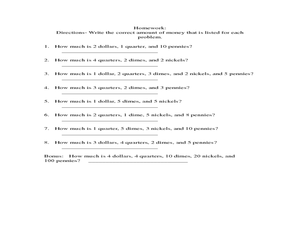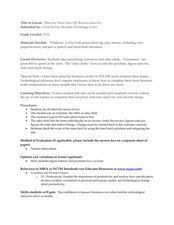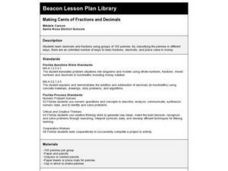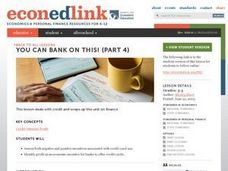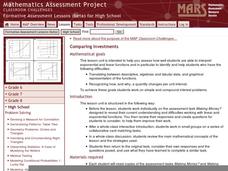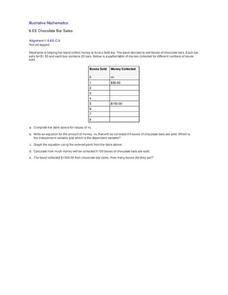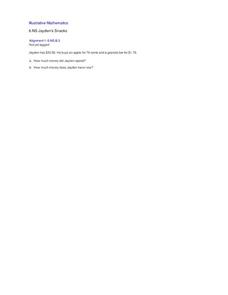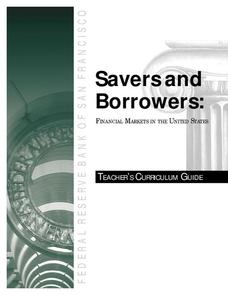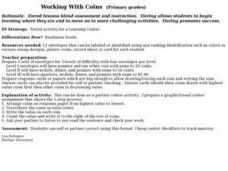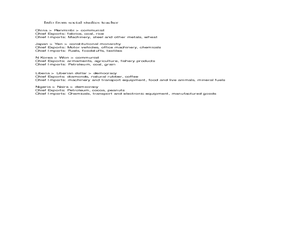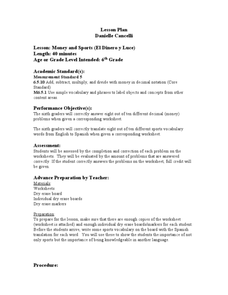Curated OER
Piggin' out with Money
Third graders manage money. In this money math lesson, 3rd graders read Pigs Will be Pigs. Students then use manipulatives to practice adding monetary amounts and making change. Students also practice working with money on selected...
Curated OER
Money and Business
Third graders use play money to complete tasks that allow them to see if the budget they came up with works. In this budget lesson plan, 3rd graders create their own budget and test it out with the play money.
Curated OER
How Much Money Do You Have?
Second graders are given 8 world problems dealing with an assortment of coins. In this money lesson plan, 2nd graders determine the answers to each problem with 100% accuracy. Students complete a worksheet that is graded.
Curated OER
When the Power Goes Off, Business Goes On
Learners participate in a scenario that involves a business with play money and a calculator. They take turns being customers and sales clerks during their simulations. This exercise assess basic math computations involved in cash...
Curated OER
Making Cents of Fractions and Decimals
Students explore decimals and fractions using groups of 100 pennies. By classifying the pennies in different ways, there are an unlimited number of ways to learn fractions, decimals, and place value in money. This is a good, hands-on...
Curated OER
Tiling Tessellations
Learners explore tessellations. In this shapes and geometry lesson, students describe the attributes of many of the shapes displayed on an Elmo. Learners create examples of tessellations using pattern blocks.
Curated OER
The Money of Great Britain
Students complete a KWL chart about money including what they would like to learn about the currency of Great Britain. In this British currency lesson, students read a text about this topic and view both American and British pictures of...
Council for Economic Education
You Can BANK on This! (Part 4)
Students assess both negative and positive incentives associated with credit card use. They identify profit as an economic incentive for banks to offer credit cards.
Curated OER
Math-Money
Students complete money matching worksheet. They work with an aid or peer tutor with coin tray, name each coin shown (use native language or alternative speech method). Alternative assessment methods are used.
Curated OER
Comparing Investments
Money, money, money. A complete lesson that makes use of different representations of simple and compound interest, including written scenarios, tables, graphs, and equations to highlight similarities and differences between linear and...
Mathematics Assessment Project
Estimating Length Using Scientific Notation
Would you rather have a million dollars or 1 x 10^6 dollars? To find the answer to this question, class members first complete an assessment task converting numbers between decimal notation and scientific notation. They then take...
Illustrative Mathematics
Chocolate Bar Sales
In this real-world example, algebra learners start to get a sense of how to represent the relationship between two variables in different ways. They start by looking at a partial table of values that define a linear relationship. They...
Curated OER
Avoiding Consumer Fraud: Financial Scams and Schemes
Young consumers get a hefty dose of information on how fraud can put their financial health at risk. The resource provides detailed lecture notes, scaffolded notetaking sheets, vocabulary worksheets, transparencies, and seven links to...
Illustrative Mathematics
Jayden’s Snacks
A quick activity to test the knowledge of your learners on adding and subtracting with decimals. They must calculate how much Jayden spent at the store and how much money he has remaining.
Curated OER
Linear or Exponential?
Your learners analyze various real-life contexts to decide if each is a linear or exponential model. This could be used as an assessment of learners' skills of discerning between a linear and an exponential model.
Pennsylvania Department of Education
Build What I've Created
n this geometric instructional activity, students define and identify two dimensional shapes based on their attributes. They complete worksheets based on the geometric concepts.
Illustrative Mathematics
Buying Protein Bars and Magazines
Packing for a trip? This activity allows learners to decide how many magazines and protein bars they can buy with twenty dollars. They can organize their work in a chart to track how many items they can purchase. There are two different...
Curated OER
Savers & Borrowers: Financial Markets in the United States
Investigate the current financial market and have your class explore savings, borrowing, financial markets, mutual funds, and the stock market. This four-part lesson is designed to help young scholars become knowledgeable and informed...
Curated OER
Working With Coins
Students arrange coins based on their value. In this coins lesson, students trace and record the value of each coin. Students count up to find the total value of all the coins.
Curated OER
Changing the Currency of Different Countries
Seventh graders explore changing currency. In this international math lesson, 7th graders will write and solve 2-step equations in order to convert currencies between nations. Students will research prices of items and currency...
Curated OER
Money and Sports
Sixth graders translate sports vocabulary words from English to Spanish and complete money problems containing decimals. In this money and sports lesson plan, 6th graders use words to communicate to each other.
Curated OER
Value of Money
Second graders examine a collection of coins to discover their value. In this value of money lesson, 2nd graders identify the amount of money represented by each coin. Students use a worksheet to complete story problems involving...
Curated OER
Technology: Money Equivalency
First graders,working on computers, drag coins into boxes to equal amounts pictured. Following a demonstration, they demonstrate how to type number sentences. As an extension, 1st graders create equivalent amounts using specific numbers...
Curated OER
Math & Science
Students are introduced to techniques to help with with math and science. In groups, they use a worksheet to discover how to count money. As a class, they watch a PowerPoint to define terms associated with science. To end the lesson,...


